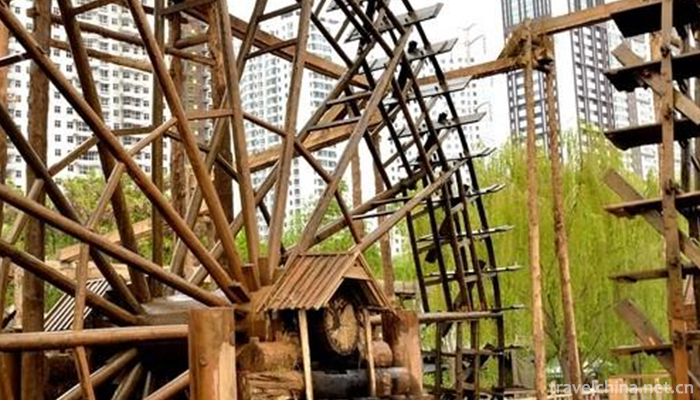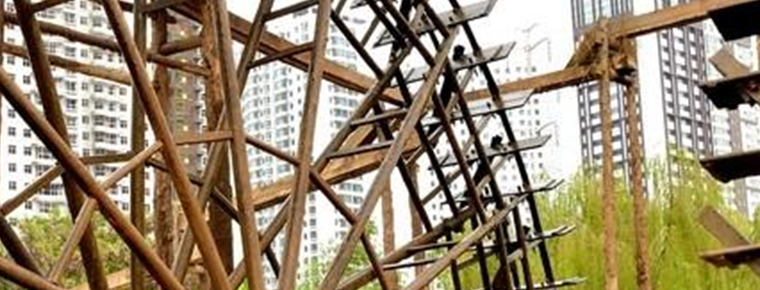Making Techniques of Lanzhou Yellow River Waterwheel
Making Techniques of Lanzhou Yellow River Waterwheel
Lanzhou Yellow River waterwheel production technology, Lanzhou City, Gansu Province, local traditional handicraft, one of the national intangible cultural heritage.
Lanzhou Yellow River waterwheel production technology uses Pinus tabulaeformis in Daxing'an Mountains and willow and elm in the north as raw materials, after drilling, pulling mortise, tenon wedge, dock, piggyback beam and axle processing, and finally on-site installation is completed.
On May 20, 2006, the craftsmanship of Lanzhou Yellow River waterwheel was approved by the State Council and listed in the first batch of national intangible cultural heritage list, project number: _-48.
historical origin
The Yellow River Waterwheel originated in the Ming Dynasty. According to the Record of Rebuilding Gaolan County, it was created by Duanjiatan Renduan in Lanzhou in the Ming Dynasty. "When Xuliju lived, he turned over the car and pulled the river upside down to irrigate the fields, which gave rise to ingenious thinking. Farmers in Chuanhe follow suit. Duan continued his career in his early years after several ups and downs, returned to his hometown in his later years, and devoted himself to the imitation of waterwheel. After many repetitions, Duan finally succeeded in Jiajing's thirty-five years (1556).
In 1556, Duan continued to learn from the irrigation technology of drum cars in Tonghe, Yunnan Province, and created a waterwheel suitable for local use in Lanzhou. Beginning to erect on the North Bank of the Yellow River outside Guangwumen. Later, three rounds were erected at the north entrance of Zhenyuan Road to irrigate more than 600 mu vegetable border orchards nearby. This is the place name "Waterwheel Park". Since the end of Ming Dynasty, water carts have been widely used in Gaolan, Baiyin, Jingchuan, Pingliang, Yinchuan and Shaanxi in the Yellow River Basin, which has promoted the development of agricultural production in these areas.
In 1952, Lanzhou waterwheel reached its heyday. There were 252 waterwheels on both sides of the Yellow River. The total irrigation area increased from more than 20,000 Mu before the founding of New China to 100,000 mu. Especially from Guangwumen to Yantan River, it is also the gathering place of waterwheel. Single-wheel, double-wheel, three-wheel, five-wheel and other forms are different and magnificent. Therefore, here is also known as "Waterwheel Park", Lanzhou is also known as "Waterwheel City".
Process characteristics
Lanzhou Dashui Truck seems to have simple structure and no traditional drawings, but it has exquisite conception, complex structure, ingenious conception, exquisite material selection, local materials, exquisite production technology, the use of Pinus tabulaeformis in the Great Hinggan Mountains and willows and elms in the north, showing the superb wisdom and excellent skills of traditional craftsmen.
1. Advanced technology, low cost, labor saving and labor convenience have changed the situation of the two sides of the Yellow River feeding on the sky, so it has the characteristics of dependence.
2. Because of the vast land and extensive use in the Yellow River Basin, it has extensive characteristics.
Thirdly, Duan Xun changed to use elm, Sophora and willow to make waterwheel according to local conditions, so it has the characteristics of simplicity.
4. Since the creation of the waterwheel, it has been standing on the Bank of the Yellow River. With the flow and inertia of the water in the Yellow River, it drives the rotation of the waterwheel, so it has the ornamental characteristics.
Inheritance and protection
Inheritance value
Lanzhou Waterwheel is an important part of the culture of the Yellow River Basin. It contributes a lot to the people of Lanzhou and the lower reaches, and plays an immeasurable role in the development of Lanzhou society. As an important part of the Yellow River culture, it also embodies the creativity of the Chinese nation and provides evidence for the study of Chinese agricultural civilization and water history.
Inheritance status
In 1952, there were still 252 water trucks along the Yellow River in Lanzhou. Since the electric irrigation technology has been widely used, the number of water trucks has been decreasing year by year, and the producers have few successors. Facing the endangered situation, it has become an urgent and important task to protect the production technology of the Yellow River water truck.
Inheriting characters
Duan Yicun, male, on May 16, 2018, Duan Yicun was selected as the representative successor of the fifth batch of national intangible cultural heritage projects, which was declared by Lanzhou City, Gansu Province. Project Name: Lanzhou Yellow River Waterwheel Manufacturing Techniques.
protective measures
On August 26, 2005, Lanzhou built a waterwheel exposition park, which reproduced the spectacular scene of waterwheel stands on both sides of the Yellow River more than 50 years ago.
In 2007, in order to protect this precious traditional cultural heritage, "Lanzhou Yellow River Waterwheel Production Techniques" was included in "Lanzhou Historical and Cultural Heritage Protection Plan", which was protected by legislation.
social influence
Important exhibition
In 2006, 2007 and 2008, Lanzhou Yellow River Waterwheel was invited to attend the China (Shenzhen) International Cultural Industry Fair (hereinafter referred to as the "Cultural Fair") held at the Shenzhen Convention and Exhibition Center, and won high praise.


-
1.Zhenjiang Sanshan Scenic Area
Zhenjiang Sanshan Scenic Area is located in the southwest of Jiangsu Province and on the South Bank of the lower reaches of the Yangtze River
Time 2018-12-06 -
2.The Huaming Tower Scenic Area
Huaming Tower Tourist Area: National AAAAA Tourist Area, National Key Cultural Relics Protection Unit, National Patriotic Education Base.
Time 2018-12-12 -
3.Langyatai Scenic Area
Langyatai Scenic Spot belongs to Qingdao Langyatai Provincial Tourism Resort (established in December 1995 with the approval of Shandong Provincial People's Government with a planned area of 9.8 squar
Time 2019-01-29 -
4.Legend of Boya Period
"When the evidence of the legendary place of Bo Yazi Period was found in Hanyang, I knew that it was hopeful to apply for the national level!" Yesterday, the reporter learned from the Provin
Time 2019-04-04 -
5.Winter capture of Chagan Lake
Winter fishing in Chagan Lake, namely ice and snow fishing (or hunting) in Chagan Lake in winter, is a traditional fishery production mode (custom) in Qianguoerros Mongolian Autonomous County
Time 2019-04-15 -
6.Ha Ni Ha Ba
Ha Ni Ha Ba, an important part of Chinese Hani folk literature. Hani Haba, which means Hani ancient songs, is a popular and far-reaching folk song in Hani social life.
Time 2019-05-02 -
7.Huang Di memorial ceremony
Yellow Emperor's sacrificial ceremony is a kind of sacrificial music and dance to celebrate Xuanyuan Huangdi's pioneering achievements in Chinese civilization. The theme of
Time 2019-05-04 -
8.Construction Techniques of Yanmen Folk House
Yanmen folk house construction technology is a traditional skill with local characteristics in Xinzhou, Shanxi Province. It was listed in the third batch of intangible cultural heritage list in 2011.
Time 2019-07-10 -
9.Yi Quan
Yiquan, also known as Dacheng Quan, is one of the traditional Chinese boxing and belongs to Neijia Quan. It comes from mind boxing. Including: standing pile, trial, footwork, strength, sound test, pus
Time 2019-07-13 -
10.Hua Mulan Movie
Mulan is produced by Walt Disney Studios. Niki Caro Directing, Liu Yifei , Donnie Yen , Gong Li , Jet Li A live action movie starring. The file was released in North America in March 27, 2020.
Time 2019-09-04 -
11.Liushi Manorial Museum
Dayi Liushi manoral museum is located at No.15, Jingui street, Anren Town, Dayi County, Chengdu City, Sichuan Province. It is one of the important historical sites and representative buildings in modern China.
Time 2020-11-05 -
12.Modern cheongsam
At the beginning of the 20th century, it was popular to wear a short jacket with trumpet shaped wide sleeves inside, and a long waistcoat without sleeves with the front and back of the coat reaching the ground. Since then, cheongsam has made some changes in the edge, sleeve
Time 2020-12-11